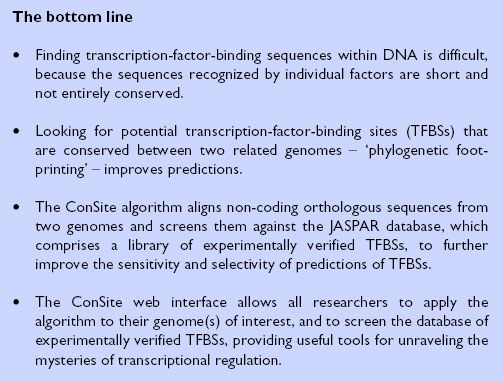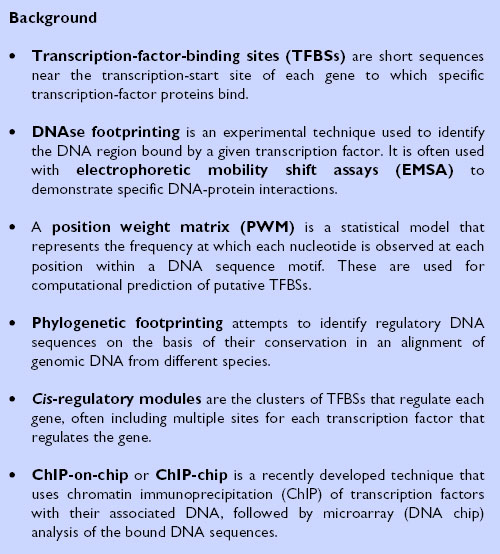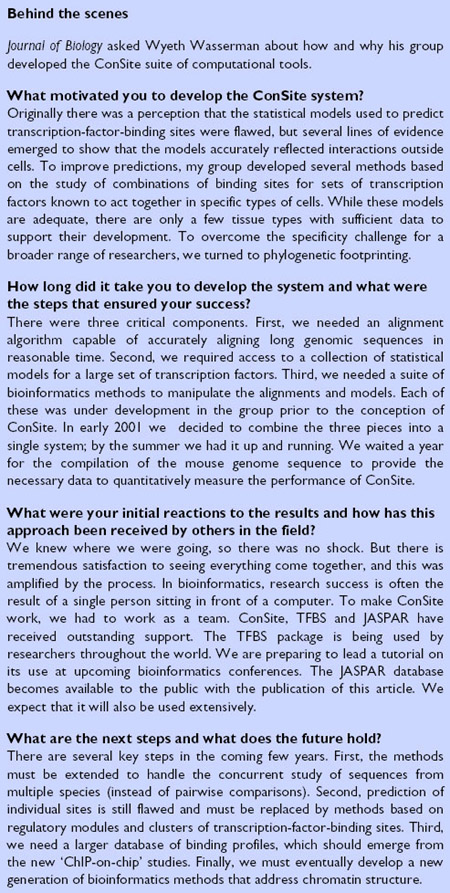Abstract
The strategy of using 'phylogenetic footprinting' to find regulatory sites that are conserved between pairs of related complex genomes has led to the development of a suite of computational tools that succeed in finding functionally important transcription-factor-binding sequences.
Celebrating the latest completed genome sequencing project is all very well, but even before the champagne runs dry questions are asked about how best to use all the sequence information. The observation that less than 2% of the human genome sequence actually encodes proteins is a sobering issue for the 'post-genomic era'. And finding functionally relevant information within the non-coding sequence presents a formidable challenge, akin to tracking footprints in a dense forest. In this issue of the Journal of Biology [1], Boris Lenhard, Albin Sandelin, Wyeth Wasserman and colleagues describe a computational approach that will benefit all researchers keen to locate and explore the regulatory elements in their chosen genome (see 'The bottom line' box for a summary of their work).
The bottom line.

Predicting binding sites
Understanding the principles that govern where and when genes are expressed is essential for deciphering how genome information is turned into the molecular and cellular phenomena that underlie the biology of complex organisms. Gene expression programs are determined through the recognition of specific promoter and enhancer sequences within the DNA by regulatory transcription-factor proteins. Transcription-factor-binding sites (TFBSs; see the 'Background' box) are short sequences, many of which have been painstakingly elucidated over the years using experimental procedures such as DNAse footprinting and electrophoretic mobility shift assays (EMSA). TFBSs tend to be short, often less that 10 base-pairs long, and thus they are likely to occur within a genome quite often simply by chance. In addition, each transcription factor appears to tolerate a wide range of variations from its simple consensus sequence, making it extremely difficult to predict binding sites by simply searching a genome sequence for consensus motifs.
Background.

"Characterization of the promoter regions of eukaryotic genes remains one of the most elusive problems in computational genome analysis," says Roderic Guigó (Institut Municipal d'Investigació Mèdica, Barcelona, Spain). To address these challenges, bioinformaticians have developed approaches using position weight matrices (PWMs) that take into account the observed frequency of tolerated sequence variations at each nucleotide position within a consensus TFBS and give a quantitative score that reflects the actual binding specificity of the factor. Extensive investigation of transcriptional regulation has provided insights into how gene expression is finely regulated by the sequence and distribution of multiple TFBSs within cis-regulatory regions upstream of each gene. Combinations of TFBSs for different factors can form cis-regulatory modules, with complex functional synergy, that drive the transcriptional machinery.
The first thing that Wyeth Wasserman's group did was build a library of high-quality PWMs. The quality of these matrices is critical for accurate site prediction. The best way to build a PWM is to plunge into the published literature and pull out relevant information from papers describing in vitro and in vivo experiments on individual transcription factors. "The collection of binding profiles, collectively termed the JASPAR database, was produced by the pure determination of Albin Sandelin for his thesis project studying the binding similarities of transcription factors in the same structural families," says Wasserman. (See the 'Behind the scenes' box for further discussion of the motivation for the work.) The team constructed over a hundred binding-profile matrices for different transcription factors. Any DNA sequence can be screened using these matrices to locate potential TFBSs. A certain number of potential sites will be identified just by chance, however, and finding a potential site doesn't guarantee that the cognate factor actually binds there or that the site is of biological relevance.
Behind the scenes.

Two genomes are better than one
When the draft of the human genome sequence was published in 2001, David Baltimore wrote the following in an accompanying commentary [2]: "Gene-regulatory sequences are now there for all to see, but initial attempts to find them were also disappointing. This is where the genomic sequences of other species - in which the regulatory sequences, but not the functionally insignificant DNA, are likely to be much the same - will open up a cornucopia". This is the basis of the method of 'phylogenetic footprinting'. The idea is that important regulatory modules are under selective pressure during evolution and that comparing two (or more) genomes will identify the conserved sequences that are most likely to be biologically relevant [3]. "Having multiple orthologous genes available provides a tremendous amount of information about what the most important features of the sequences are. It is the most valuable of 'sequence only' data," says computational biologist Gary Stormo (Washington University School of Medicine, St Louis, USA). Guigó adds "in fact, we can say that without the genomes of other species, it will be impossible to fully understand the human genome."
Having assembled the JASPAR database, the second feature of the Wasserman team's approach was to create tools for aligning long stretches of genomic DNA. "The alignment algorithm by Luis Mendoza (originally called DPB and now re-engineered and named ORCA) is part of a bioinformatics system termed OrthoSeq that is undergoing final revisions," says Wasserman. Phylogenetic footprinting approaches have proved powerful in previous studies of particular genomic loci but have rarely been applied on a genome-wide scale [4-7].
The final challenge was to combine the genome-alignment tools with the PWMs to create a system that was easy to use. "The third component, the computer methods, were the focus of a project by Boris Lenhard to create a suite of computer programming resources for researchers engaged in the study of regulatory sequences. This system, the TFBS Perl module, has been available for about a year and is already being broadly used in the field," says Wasserman.
When these three elements were combined, ConSite was born [8]. The authors are eager for their tools to be widely used and have done their best to make them accessible and user-friendly. "This collection is a resource for the global bioinformatics community," says Wasserman. "As opposed to commercial databases of transcription-factor information, we make our data available without restriction to academic research groups. Consistent with the philosophy of Journal of Biology and the Public Library of Science [9], we believe in open data access."
Time for testing
With the ConSite suite of tools assembled, Lenhard et al. [1] conducted several tests to demonstrate the utility of their approach. They analyzed a number of well-characterized human gene promoter regions, comparing sequences with mouse and cow orthologs. They showed that adding the phylogenetic footprinting step improved the selectivity of TFBS prediction by 85% without a great loss of sensitivity. "Phylogenetic footprinting had already been postulated as a means to improve the characterization of the promoter regions of the genes in higher eukaryotic genomes, but the Wasserman article shows that the idea really works," says Guigó. Stormo comments that such programs cannot claim to be fully comprehensive; they will miss some sites, "but the sites that it does identify have a much greater probability of being important. So the reported sites will have a low false-positive rate, in contrast to some of the previous approaches".
The ConSite platform is likely to undergo many modifications and updates as bioinformaticians add new features and capabilities. The ability to align multiple sequences should further improve the phylogenetic footprinting selectivity. "[The authors] don't try to discover new types of sites, just to reliably identify the occurrences of sites for known transcription factors. But the approach can be extended to identifying new sites," says Stormo.
In the future, information from bioinformatic analyses might be combined with experimental datasets to construct models for complex transcriptional regulatory networks. Stormo envisages incorporating data from experiments using microarray analysis, ChIP-on-chip and mutant phenotyping to get a more complete picture of network connections. A recent study from Richard Young and colleagues [10] demonstrated how these approaches can be applied on a genome-wide scale in yeast.
Understanding the genetic networks regulated by transcription-factor activity will not only provide molecular insights into fundamental biological processes: it is also relevant to many disease pathologies and may perhaps indicate novel therapeutic strategies. Computational approaches such as ConSite will prove invaluable in this endeavor. Hunters of the past and present have always begun by tracking down the footprints. Now, genetic hunters have a powerful set of tools to help with their task.
References
- Lenhard B, Sandelin A, Mendoza L, Engström P, Jareborg N, Wasserman WW. Identification of conserved regulatory elements by comparative genome analysis. J Biol. 2003;2:13. doi: 10.1186/1475-4924-2-13. [DOI] [PMC free article] [PubMed] [Google Scholar]
- Baltimore D. Our genome unveiled. Nature. 2001;409:814–816. doi: 10.1038/35057267. [DOI] [PubMed] [Google Scholar]
- Ureta-Vida Al, Ettwiller L, Birney E. Comparative genomics: genome-wide analysis in metazoan eukaryotes. Nat Rev Genet. 2003;4:251–262. doi: 10.1038/nrg1043. [DOI] [PubMed] [Google Scholar]
- Loots GG, Locksley RM, Blankespoor CM, Wang ZE, Miller W, Rubin EM, Frazer KA. Identification of a coordinate regulator of interleukins 4, 13, and 5 by cross-species sequence comparisons. Science. 2000;288:136–140. doi: 10.1126/science.288.5463.136. [DOI] [PubMed] [Google Scholar]
- Boffelli D, McAuliffe J, Ovcharenko D, Lewis KD, Ovcharenko I, Pachter L, Rubin EM. Phylogenetic shadowing of primate sequences to find functional regions of the human genome. Science. 2003;299:1391–1394. doi: 10.1126/science.1081331. [DOI] [PubMed] [Google Scholar]
- Kellis M, Patterson N, Endrizzi M, Birren B, Lander ES. Sequencing and comparison of yeast species to identify genes and regulatory elements. Nature. 2003;423:241–254. doi: 10.1038/nature01644. [DOI] [PubMed] [Google Scholar]
- Cliften P, Sudarsanam P, Desikan A, Fulton L, Fulton B, Majors J, Waterston R, Cohen BA, Johnston M. Finding functional features in Saccharomyces genomes by phylogenetic footprinting. Science. 2003. Published online May 29; doi 101126/science.1084337. [DOI] [PubMed]
- ConSite http://www.phylofoot.org/consite
- Public Library of Science http://www.plos.org
- Lee TI, Rinaldi NJ, Robert F, Odom DT, Bar-Joseph Z, Gerber GK, Hannett NM, Harbison CT, Thompson CM, Simon I, et al. Transcriptional regulatory networks in Saccharomyces cerevisiae. Science. 2002;298:799–804. doi: 10.1126/science.1075090. [DOI] [PubMed] [Google Scholar]


